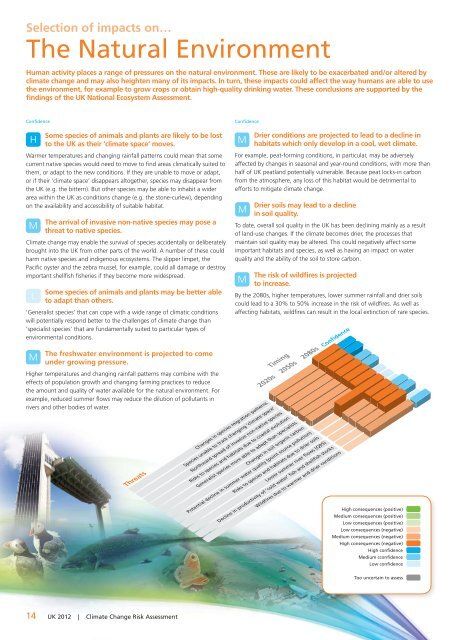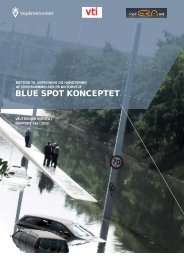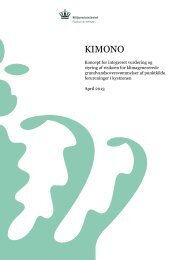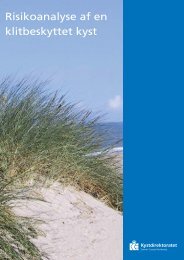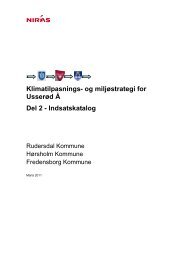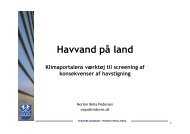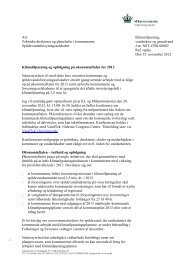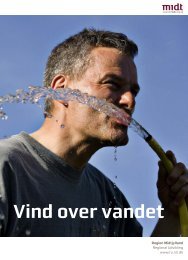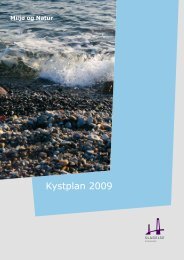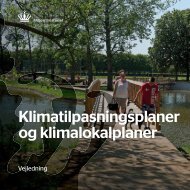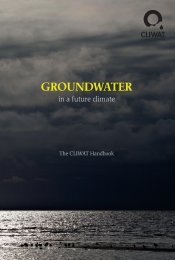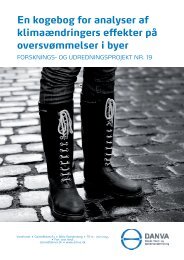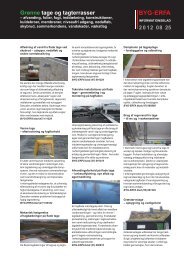Summary of key findings from the CCRA - Defra
Summary of key findings from the CCRA - Defra
Summary of key findings from the CCRA - Defra
You also want an ePaper? Increase the reach of your titles
YUMPU automatically turns print PDFs into web optimized ePapers that Google loves.
Selection <strong>of</strong> impacts on…<br />
The Natural Environment<br />
Human activity places a range <strong>of</strong> pressures on <strong>the</strong> natural environment. These are likely to be exacerbated and/or altered by<br />
climate change and may also heighten many <strong>of</strong> its impacts. In turn, <strong>the</strong>se impacts could affect <strong>the</strong> way humans are able to use<br />
<strong>the</strong> environment, for example to grow crops or obtain high-quality drinking water. These conclusions are supported by <strong>the</strong><br />
<strong>findings</strong> <strong>of</strong> <strong>the</strong> UK National Ecosystem Assessment.<br />
Confidence<br />
H<br />
Some species <strong>of</strong> animals and plants are likely to be lost<br />
to <strong>the</strong> UK as <strong>the</strong>ir ‘climate space’ moves.<br />
Warmer temperatures and changing rainfall patterns could mean that some<br />
current native species would need to move to find areas climatically suited to<br />
<strong>the</strong>m, or adapt to <strong>the</strong> new conditions. If <strong>the</strong>y are unable to move or adapt,<br />
or if <strong>the</strong>ir ‘climate space’ disappears altoge<strong>the</strong>r, species may disappear <strong>from</strong><br />
<strong>the</strong> UK (e.g. <strong>the</strong> bittern). But o<strong>the</strong>r species may be able to inhabit a wider<br />
area within <strong>the</strong> UK as conditions change (e.g. <strong>the</strong> stone-curlew), depending<br />
on <strong>the</strong> availability and accessibility <strong>of</strong> suitable habitat.<br />
M<br />
The arrival <strong>of</strong> invasive non-native species may pose a<br />
threat to native species.<br />
Climate change may enable <strong>the</strong> survival <strong>of</strong> species accidentally or deliberately<br />
brought into <strong>the</strong> UK <strong>from</strong> o<strong>the</strong>r parts <strong>of</strong> <strong>the</strong> world. A number <strong>of</strong> <strong>the</strong>se could<br />
harm native species and indigenous ecosystems. The slipper limpet, <strong>the</strong><br />
Pacific oyster and <strong>the</strong> zebra mussel, for example, could all damage or destroy<br />
important shellfish fisheries if <strong>the</strong>y become more widespread.<br />
L<br />
Some species <strong>of</strong> animals and plants may be better able<br />
to adapt than o<strong>the</strong>rs.<br />
‘Generalist species’ that can cope with a wide range <strong>of</strong> climatic conditions<br />
will potentially respond better to <strong>the</strong> challenges <strong>of</strong> climate change than<br />
‘specialist species’ that are fundamentally suited to particular types <strong>of</strong><br />
environmental conditions.<br />
Confidence<br />
M<br />
Drier conditions are projected to lead to a decline in<br />
habitats which only develop in a cool, wet climate.<br />
For example, peat-forming conditions, in particular, may be adversely<br />
affected by changes in seasonal and year-round conditions, with more than<br />
half <strong>of</strong> UK peatland potentially vulnerable. Because peat locks-in carbon<br />
<strong>from</strong> <strong>the</strong> atmosphere, any loss <strong>of</strong> this habitat would be detrimental to<br />
efforts to mitigate climate change.<br />
M<br />
Drier soils may lead to a decline<br />
in soil quality.<br />
To date, overall soil quality in <strong>the</strong> UK has been declining mainly as a result<br />
<strong>of</strong> land-use changes. If <strong>the</strong> climate becomes drier, <strong>the</strong> processes that<br />
maintain soil quality may be altered. This could negatively affect some<br />
important habitats and species, as well as having an impact on water<br />
quality and <strong>the</strong> ability <strong>of</strong> <strong>the</strong> soil to store carbon.<br />
M<br />
The risk <strong>of</strong> wildfires is projected<br />
to increase.<br />
By <strong>the</strong> 2080s, higher temperatures, lower summer rainfall and drier soils<br />
could lead to a 30% to 50% increase in <strong>the</strong> risk <strong>of</strong> wildfires. As well as<br />
affecting habitats, wildfires can result in <strong>the</strong> local extinction <strong>of</strong> rare species.<br />
M<br />
The freshwater environment is projected to come<br />
under growing pressure.<br />
Higher temperatures and changing rainfall patterns may combine with <strong>the</strong><br />
effects <strong>of</strong> population growth and changing farming practices to reduce<br />
<strong>the</strong> amount and quality <strong>of</strong> water available for <strong>the</strong> natural environment. For<br />
example, reduced summer flows may reduce <strong>the</strong> dilution <strong>of</strong> pollutants in<br />
rivers and o<strong>the</strong>r bodies <strong>of</strong> water.<br />
High consequences (positive)<br />
Medium consequences (positive)<br />
Low consequences (positive)<br />
Low consequences (negative)<br />
Medium consequences (negative)<br />
High consequences (negative)<br />
High confidence<br />
Medium cconfidence<br />
Low confidence<br />
Too uncertain to assess<br />
14 UK 2012 | Climate Change Risk Assessment


